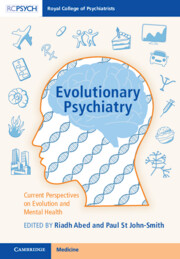Book contents
- Evolutionary Psychiatry
- Reviews
- Evolutionary Psychiatry
- Copyright page
- Contents
- Contributors
- Foreword
- Preface
- Chapter 1 Introduction to Evolutionary Psychiatry
- Chapter 2 The Biopsychosocial Model Advanced by Evolutionary Theory
- Chapter 3 Hominin Evolution I
- Chapter 4 Hominin Evolution II
- Chapter 5 Hunter-Gatherers, Mismatch and Mental Disorder
- Chapter 6 Why Do Mental Disorders Persist?
- Chapter 7 Anxiety Disorders in Evolutionary Perspective
- Chapter 8 Evolutionary Perspectives on Depression
- Chapter 9 On the Randomness of Suicide
- Chapter 10 Evolutionary Perspectives on Schizophrenia Spectrum Disorders
- Chapter 11 Evolutionary Perspectives on Eating Disorders
- Chapter 12 Substance Abuse and Evolution
- Chapter 13 The Social Function of Alcohol from an Evolutionary Perspective
- Chapter 14 Evolutionary Perspectives on Childhood Trauma
- Chapter 15 Evolutionary Perspectives on Neurodevelopmental Disorders
- Chapter 16 Maternal Negativity and Child Maltreatment
- Chapter 17 Alzheimer’s Disease as a Disease of Evolutionary Mismatch, with a Focus on Reproductive Life History
- Chapter 18 Psychopharmacology and Evolution
- Chapter 19 What the Evolutionary and Cognitive Sciences Offer the Sciences of Crime and Justice
- Chapter 20 Evolutionary Thinking and Clinical Care of Psychiatric Patients
- Index
- References
Chapter 11 - Evolutionary Perspectives on Eating Disorders
Published online by Cambridge University Press: 08 September 2022
- Evolutionary Psychiatry
- Reviews
- Evolutionary Psychiatry
- Copyright page
- Contents
- Contributors
- Foreword
- Preface
- Chapter 1 Introduction to Evolutionary Psychiatry
- Chapter 2 The Biopsychosocial Model Advanced by Evolutionary Theory
- Chapter 3 Hominin Evolution I
- Chapter 4 Hominin Evolution II
- Chapter 5 Hunter-Gatherers, Mismatch and Mental Disorder
- Chapter 6 Why Do Mental Disorders Persist?
- Chapter 7 Anxiety Disorders in Evolutionary Perspective
- Chapter 8 Evolutionary Perspectives on Depression
- Chapter 9 On the Randomness of Suicide
- Chapter 10 Evolutionary Perspectives on Schizophrenia Spectrum Disorders
- Chapter 11 Evolutionary Perspectives on Eating Disorders
- Chapter 12 Substance Abuse and Evolution
- Chapter 13 The Social Function of Alcohol from an Evolutionary Perspective
- Chapter 14 Evolutionary Perspectives on Childhood Trauma
- Chapter 15 Evolutionary Perspectives on Neurodevelopmental Disorders
- Chapter 16 Maternal Negativity and Child Maltreatment
- Chapter 17 Alzheimer’s Disease as a Disease of Evolutionary Mismatch, with a Focus on Reproductive Life History
- Chapter 18 Psychopharmacology and Evolution
- Chapter 19 What the Evolutionary and Cognitive Sciences Offer the Sciences of Crime and Justice
- Chapter 20 Evolutionary Thinking and Clinical Care of Psychiatric Patients
- Index
- References
Summary
The focus of this chapter is on evolutionary theories and models of anorexia nervosa (AN), bulimia nervosa (BN) and obesity. Although obesity is not considered a mental health problem, its link with binge eating disorder and its massively increased prevalence in recent decades, in association with modernisation and Westernisation together with increased morbidity and mortality, have stimulated much evolutionary theorising. Disorders of eating and weight are of particular interest to evolutionary scholars for a number of reasons. These include the claim that many of these disorders are evolutionarily novel, that they have increased in prevalence in developed countries in recent decades, that they have a large female preponderance, particularly of AN and BN, and that they have an increased risk of mortality. Our poor understanding of the aetiology of eating disorders together with poor outcomes (especially for AN) has been associated with a proliferation of proximate theories/models within mainstream psychiatry but without any one theory gaining wide acceptance. This presents an opportunity for evolutionary models to propose new ways of thinking and new avenues for research on these disorders. A review of the current evolutionary literature on AN and BN shows that despite the wide range and variety of models, the sexual competition hypothesis has, so far, had the strongest empirical support from clinical and non-clinical studies. While other evolutionary theories focus on AN, the sexual competition hypothesis provides an explanation for both AN and BN, as well as for the widespread dieting seen in the population. Furthermore, it uniquely makes sense of the specific presentations of eating disorders in males. Nevertheless, it seems increasingly clear that intrasexual competition is not the whole story. More recent work that considers other areas of mismatch in the modern environment represents a necessary extension to this theoretical perspective. It is concluded that larger-scale studies on clinical populations are required to put these theoretical formulations to the test and to explore their potential clinical utility.
Keywords
- Type
- Chapter
- Information
- Evolutionary PsychiatryCurrent Perspectives on Evolution and Mental Health, pp. 169 - 185Publisher: Cambridge University PressPrint publication year: 2022
References
- 1
- Cited by



